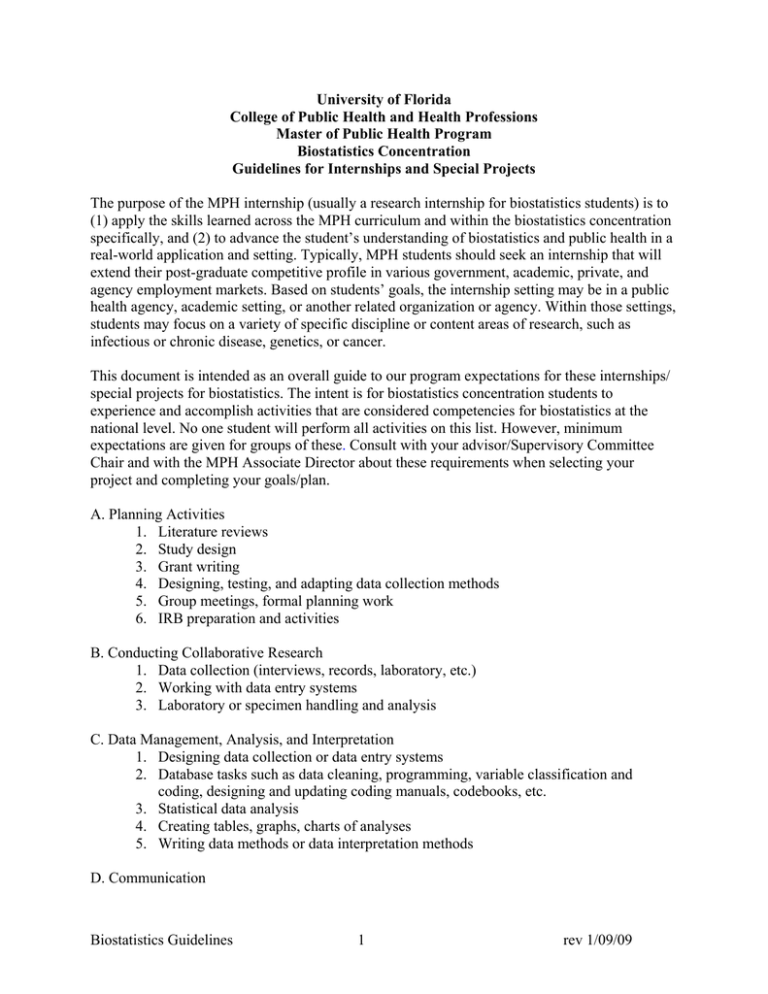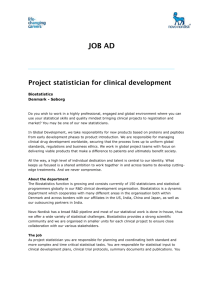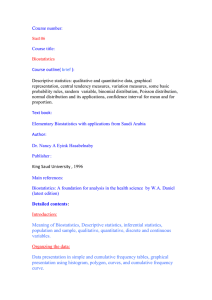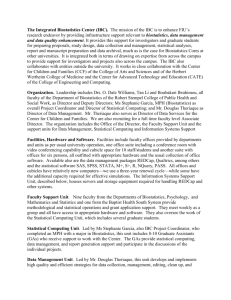University of Florida College of Public Health and Health Professions Biostatistics Concentration
advertisement

University of Florida College of Public Health and Health Professions Master of Public Health Program Biostatistics Concentration Guidelines for Internships and Special Projects The purpose of the MPH internship (usually a research internship for biostatistics students) is to (1) apply the skills learned across the MPH curriculum and within the biostatistics concentration specifically, and (2) to advance the student’s understanding of biostatistics and public health in a real-world application and setting. Typically, MPH students should seek an internship that will extend their post-graduate competitive profile in various government, academic, private, and agency employment markets. Based on students’ goals, the internship setting may be in a public health agency, academic setting, or another related organization or agency. Within those settings, students may focus on a variety of specific discipline or content areas of research, such as infectious or chronic disease, genetics, or cancer. This document is intended as an overall guide to our program expectations for these internships/ special projects for biostatistics. The intent is for biostatistics concentration students to experience and accomplish activities that are considered competencies for biostatistics at the national level. No one student will perform all activities on this list. However, minimum expectations are given for groups of these. Consult with your advisor/Supervisory Committee Chair and with the MPH Associate Director about these requirements when selecting your project and completing your goals/plan. A. Planning Activities 1. Literature reviews 2. Study design 3. Grant writing 4. Designing, testing, and adapting data collection methods 5. Group meetings, formal planning work 6. IRB preparation and activities B. Conducting Collaborative Research 1. Data collection (interviews, records, laboratory, etc.) 2. Working with data entry systems 3. Laboratory or specimen handling and analysis C. Data Management, Analysis, and Interpretation 1. Designing data collection or data entry systems 2. Database tasks such as data cleaning, programming, variable classification and coding, designing and updating coding manuals, codebooks, etc. 3. Statistical data analysis 4. Creating tables, graphs, charts of analyses 5. Writing data methods or data interpretation methods D. Communication Biostatistics Guidelines 1 rev 1/09/09 1. Routine memos, forms, files, calls, and electronic communications with team and others for the internship 2. Written reports and findings 3. Graphics, slides, or the aids in communicating results 4. Oral presentations 5. Disseminating results, e.g., community feedback, newsletters, reports to subjects, etc. E. Teams and Systems 1. Working with a lab, clinic, research group 2. Integrating activities at more than one level, e.g., investigator and department, local and global, community and individual, laboratory and population, etc. 3. Establishing or working in a partnership F. Community, Population-Level Thinking 1. Activities that relate to group levels, e.g., communities, nation, special subgroups Biostatistics Guidelines 2 rev 1/09/09




